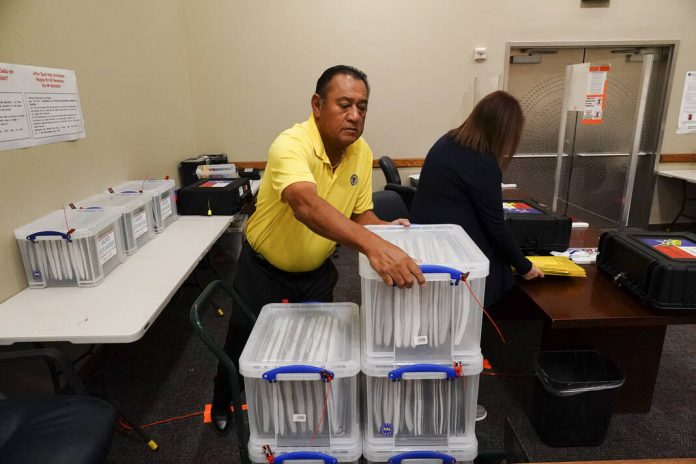HARLINGEN — Cameron County residents are going to the polls in strong numbers for early voting, closing in on 2018’s record mid-term election turnout amid heavily contested races as Republicans challenge Democrats in the Rio Grande Valley’s traditionally Democratic stronghold.
After the first five days of voting, the polls closed at 7 p.m. Friday, with 26,043 voters casting ballots, according to the Cameron County Elections Department’s tally.
Early voting runs through Nov. 4.
In the record-setting 2018 mid-term election, 79,358 residents cast early votes, Remi Garza, the county’s elections administrator, said, adding 40,439 had cast early ballots in 2014’s mid-term election.
“We’re seeing numbers similar in strength but we’re slightly behind where we were at the same time four years ago,” Garza said. “There’s still a lot of time between now and Election Day for people to exercise their right to vote.”
Heated races
On a crowded ballot packed with heavily contested races, the national spotlight is on the match for District 34’s congressional seat pitting incumbent Republican Mayra Flores against U.S. Rep. Vicente Gonzalez, a Democrat who switched out of District 15, where he had first won election in 2017.
In June, Flores won a special election after past U.S. Rep. Filemon Vela, a Democrat, resigned the post in March to take a job as a lobbyist.
In one of the county’s most heated races, Democrat Eddie Trevino Jr., who took office in 2016, faces Republican Carlos Cascos, a former secretary of state and county judge.
“We have a lot of interest in the community,” Garza said, referring to the ballot’s contested races.
New voters going to polls
The election is driving new voters to the polls.
“We have a larger voter base,” Garza said.
Since the 2020 election, more than 20,000 residents have registered to vote, pushing the county’s number of registered voters to 227,748, he said.
“We’ve seen a significant increase in registration,” he said. “We’ve got a significant increase in community advocacy after the 2016 presidential election.”
Key issues
Concerns surrounding the economy are drawing many voters to the polls, Jared Hockema, the county’s Democratic Party chairman, and Morgan Cisneros Graham, the Republican Party’s chairwoman, said.
For many voters, “border security” is a big issue, Cisneros Graham said.
Meanwhile, more women are going to the polls as a result of the U.S. Supreme Court’s landmark June ruling overturning Rowe vs. Wade, Hockema said.
“It is driving women down here to vote,” he said.
Early voting demographics
So far, the election’s early voting list, which includes information on voters who have cast ballots, is offering a snap-shot into voters’ demographics.
“We know who it shows is turning out,” Cisneros Graham said.
During the first three days of early voting, 72 percent of voters were Hispanic, 52 percent were women and 2,120 were under 35 years old, Hockema said, noting the county’s population is vastly Hispanic and under 35.
“The turnout doesn’t reflect the demographics,” he said. “Every vote is going to count in this election.”
Two-party system
In the Valley, the Republican Party is challenging Democrats’ traditional stronghold.
“Now, the RGV is starting to get a competitive two-party election process,” Cisneros Graham said. “For once, people actually have congressional races where people are being courted.”
Meanwhile, she pointed to local Republican women challenging the county’s traditional Democratic base.
“We have invigorated, intelligent and attractive Latinas who are actually courting them with platforms that resonate against these male-establishment types who feel so entitled to their votes they didn’t even campaign last time.”
Across Texas, the election’s state-wide voter turnout is “actually leaning Republican,” Cisneros Graham said.
“Things are looking good for Republicans across the state,” she said.
Contested races
Meanwhile, Republican candidates are outspending Democrats, Hockema said.
“There’s been a lot of effort on the part of both campaigns in this election,” he said, referring to Democratic and Republican campaigns. “We don’t have the same resources but we have the people on our side.”
Across the Valley, the Republican Party along with aligned political action committees are spending millions of dollars to back their candidates, Hockema said.
“They’re pumping millions and millions of dollars,” he said. “You see a tremendous amount of money coming from the outside.”
Meanwhile, Cisneros Graham pointed to a “grass-roots” movement as drawing more Republican voters.
“It doesn’t come from the GOP down,” she said. “It comes from the bottom-up and it comes from grass-roots.”




